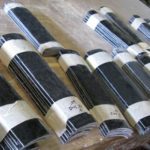TYPES & SIZES
INSTALLATION & MAINTENANCE
ADDITIONAL INFORMATION
- FRP Wear Pads minimize maintenance and operational costs
- Does not require welding, skilled personnel, or hot work permits
- All Wear Pads come with pre-roughened inside for high epoxy bonding adhesion
- We can provide alternative non-metallic wear pads such as neoprene to prevent metal to metal contact
- PT&P also designs and fabricates pipe supports that will be installed on FRP piping systems
- Have a problem with your current FRP Wear Pads? Contact PT&P’s Field Services for your installation and inspection needs
REQUEST A QUOTE

















